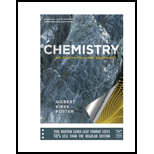
To calculate:
Molar mass and molecular formula of eugenol.
Answer to Problem 11.75QA
Solution:
a.
b.
Explanation of Solution
1. Concept:
We need moles of eugenol to find the molar mass. Therefore, we are using boiling point elevation formula to find the molality. Using molality and the volume of the solvent (CCl4), we can get moles of eugenol. Using given percent composition of C, H and O, we can get the empirical formula. From empirical formula mass and the calculated molar mass, we can derive the molecular formula of eugenol. As eugenol is an organic compound, it cannot dissociate into ions. Therefore, we assume the value of van’t Hoff factor to be 1.
2. Formula:
i.
ii.
A mole is the SI unit of amount chemical substance. When writing units, it is written as “mol”.
3. Given:
i.
ii.
iii.
iv.
v.
vi.
4. Calculations:
a.
Converting mass from milligrams to grams as follows:
Rearranging the equation for “m”, we get
Molality is defined as
Inserting the values for kg of solvent (CCl4) and molality of solution, we find moles of solute (eugenol)
Arranging for moles of solute (eugenol), we get
b.
Let’s assume the mass of whole compound to be
Finding moles of each C, H, and O using atomic weights as follows:
Dividing each mole by least number of moles, empirical formula of the eugenol is C5H6O.
Molar mass calculated above is
Conclusion:
a.
b.
c.
Want to see more full solutions like this?
Chapter 11 Solutions
Chemistry: An Atoms-Focused Approach
 ChemistryChemistryISBN:9781305957404Author:Steven S. Zumdahl, Susan A. Zumdahl, Donald J. DeCostePublisher:Cengage Learning
ChemistryChemistryISBN:9781305957404Author:Steven S. Zumdahl, Susan A. Zumdahl, Donald J. DeCostePublisher:Cengage Learning ChemistryChemistryISBN:9781259911156Author:Raymond Chang Dr., Jason Overby ProfessorPublisher:McGraw-Hill Education
ChemistryChemistryISBN:9781259911156Author:Raymond Chang Dr., Jason Overby ProfessorPublisher:McGraw-Hill Education Principles of Instrumental AnalysisChemistryISBN:9781305577213Author:Douglas A. Skoog, F. James Holler, Stanley R. CrouchPublisher:Cengage Learning
Principles of Instrumental AnalysisChemistryISBN:9781305577213Author:Douglas A. Skoog, F. James Holler, Stanley R. CrouchPublisher:Cengage Learning Organic ChemistryChemistryISBN:9780078021558Author:Janice Gorzynski Smith Dr.Publisher:McGraw-Hill Education
Organic ChemistryChemistryISBN:9780078021558Author:Janice Gorzynski Smith Dr.Publisher:McGraw-Hill Education Chemistry: Principles and ReactionsChemistryISBN:9781305079373Author:William L. Masterton, Cecile N. HurleyPublisher:Cengage Learning
Chemistry: Principles and ReactionsChemistryISBN:9781305079373Author:William L. Masterton, Cecile N. HurleyPublisher:Cengage Learning Elementary Principles of Chemical Processes, Bind...ChemistryISBN:9781118431221Author:Richard M. Felder, Ronald W. Rousseau, Lisa G. BullardPublisher:WILEY
Elementary Principles of Chemical Processes, Bind...ChemistryISBN:9781118431221Author:Richard M. Felder, Ronald W. Rousseau, Lisa G. BullardPublisher:WILEY





